Q&A: How Do I Know if I’m Eating the Right Amount for PCOS?
- Lisa Smith Nutritionist

- 2 days ago
- 4 min read
Updated: 9 hours ago

Welcome to Ask Lisa, a monthly Q&A series where I answer real questions from women navigating PCOS in everyday life.
These are the kinds of questions that come up in consultations, coaching calls and even voice note check-ins.
They’re often the questions that don’t always have simple answers, because PCOS symptoms show up differently for each of us.
My aim here is to break things down clearly, explain what might be going on beneath the surface, and offer practical steps you can start using straight away. No overwhelm, no rigid plans, no pressure to be perfect. Just evidence-based guidance to help you feel more informed and more in control of your body.
If you have a question you’d like me to cover in an upcoming Q&A, you can send it to me privately and I’ll include it anonymously.
Q: I’ve been trying to eat “healthy” for PCOS, but I’m confused about how much food I actually need. I’m not losing weight and sometimes feel hungry all the time. How do I know if I’m eating the right amount?
This is one of the most common questions I hear from women with PCOS, especially after coming off restrictive diets or calorie tracking apps. The truth is, with PCOS, it’s not just about how much you eat, but what and when you eat that matters most for hormone balance.
Let’s go through a few key points to help you understand how to find your balance without counting every gram.
Q: Do women with PCOS need fewer calories?
Not necessarily. Many women are told to eat less to manage weight, but under-eating can actually make PCOS symptoms worse.
When calorie intake drops too low:
Cortisol (your stress hormone) rises
Thyroid hormones slow down
Ovulation can be delayed or stop altogether
Cravings and fatigue increase
This creates a cycle of restriction followed by overeating, which disrupts blood sugar balance and drives more insulin resistance, which is the opposite of what you want.
A better approach is to focus on blood sugar balance and satiety rather than calories.
Q: So what does a balanced plate for PCOS look like?
In the begining, I teach my clients to start by using the 3–3–3 method as a simple visual guide:
1/3 protein: roughly a palm-sized portion - chicken, fish, eggs, tofu, lentils, or Greek yoghurt.
1/3 fibre-rich vegetables: non-starchy veg like broccoli, spinach, peppers, or courgette for antioxidants and gut support.
1/3 slow carbohydrates: such as oats, quinoa, brown rice, or sweet potato for steady energy.
Add a thumb-sized portion of healthy fats like olive oil, nuts, or avocado to support hormone production.
This simple structure keeps blood sugar stable, supports metabolism, and prevents the energy dips that often lead to cravings.
Q: Should I be tracking calories or macros with PCOS?
Tracking can help you learn what’s in your food, but it’s not a long-term solution. Women with PCOS often do better focusing on meal quality and consistency rather than strict numbers.
If you enjoy structure, use tracking short term like my client interactive journals, to spot patterns, for example, noticing you’re eating too little protein or skipping lunch. But long-term, intuitive tracking (listening to hunger, fullness, and energy cues) helps you build a sustainable routine that supports your hormones.
Q: What are signs I’m not eating enough?
Here are some red flags I see often in clients:
Feeling lightheaded, shaky, or irritable between meals
Poor sleep or waking up hungry at night
Sugar or carb cravings after dinner
Low energy despite “healthy eating”
Irregular or missing cycles
Plateaued weight despite eating less
If any of these sound familiar, it’s a sign your body’s under-fuelled and your metabolism may be protecting itself by slowing down.
Q: What about women who feel they’re always hungry or never full?
This is usually linked to blood sugar dysregulation. Many women with PCOS produce more insulin, which can make you feel hungry shortly after eating.
To manage this:
Include 20–30g protein per meal (it’s the most satiating macronutrient)
Add healthy fats to slow digestion
Limit liquid calories or smoothies that digest too quickly
Eat regularly (every 3–4 hours) until hunger and energy stabilise
It’s not about eating less, it’s about eating smarter for your metabolism.
Q: How do I know if I’m getting enough protein for PCOS?
Protein helps balance insulin, reduce cravings, and maintain lean muscle mass. Most women I see aren’t eating enough.
As a simple guide:
Aim for 20–30g protein per main meal
Add 10–15g in snacks (like Greek yoghurt, nuts, or boiled eggs)
That’s roughly:
2 eggs + ½ avocado on seeded toast
100–120g chicken or fish
200g Greek yoghurt with berries
½ cup cooked lentils or tofu
If you feel more satisfied between meals and have steadier energy, you’re likely hitting the right range. If you would like some ideas of how to increase protein in your meals this post will help.
Q: Can eating more actually help me lose weight with PCOS?
Yes, when done strategically. If you’ve been chronically under-eating, gradually increasing protein, fibre, and healthy fats can stabilise blood sugar, lower cortisol, and improve ovulation, all of which support weight management over time.
Clients often notice:
Fewer cravings
Better sleep
More energy for movement
Improved digestion and fewer energy crashes
Your metabolism can’t work efficiently without fuel. Eating enough of the right foods can help your body trust it’s no longer in “starvation mode.” If you are struggling with cravings try my free Crush Cravings sample meal plan.
Q: What’s the best way to start without feeling overwhelmed?
Start small. For example:
Add one extra source of protein to breakfast
Make sure you’re not skipping lunch
Include a mix of carbs, protein, and fats at every meal
Plan snacks ahead of time - like almonds with berries or hummus with oatcakes
If you’re unsure where to start, my free PCOS Nutrition Reset and 12-Week Hormone Shift Method both include step-by-step meal guides with hormone-friendly recipes that make this process simple and realistic.
Final Thoughts
You don’t need to count every calorie or eliminate entire food groups to feel better with PCOS. The goal is to eat in a way that keeps your hormones, blood sugar, and metabolism stable — without restriction.
With the right meal structure and consistent nourishment, your body can start working with you again rather than against you.
Disclaimer
This content is for educational purposes only and should not replace individual nutrition or medical advice. Always seek personalised guidance from a registered nutrition professional before making significant dietary changes.






Comments